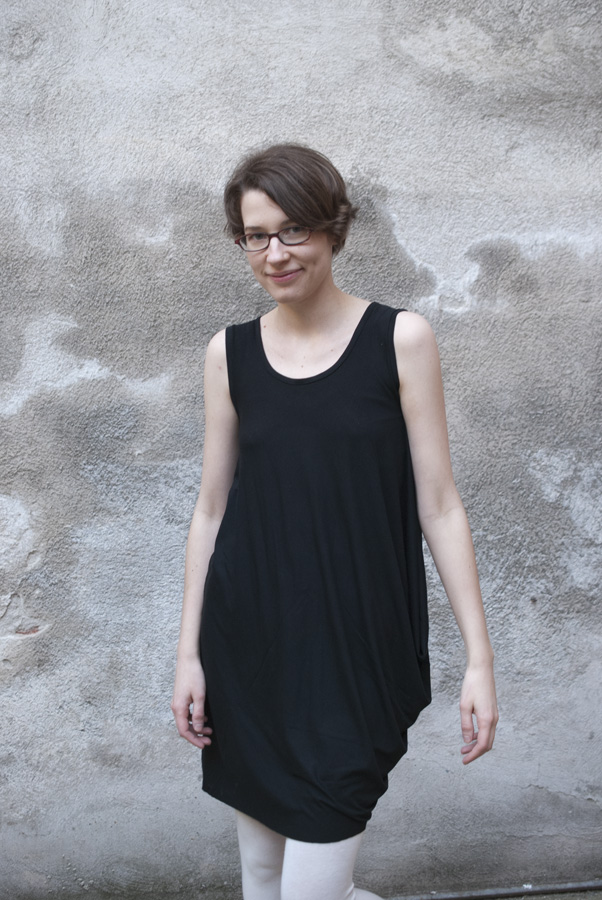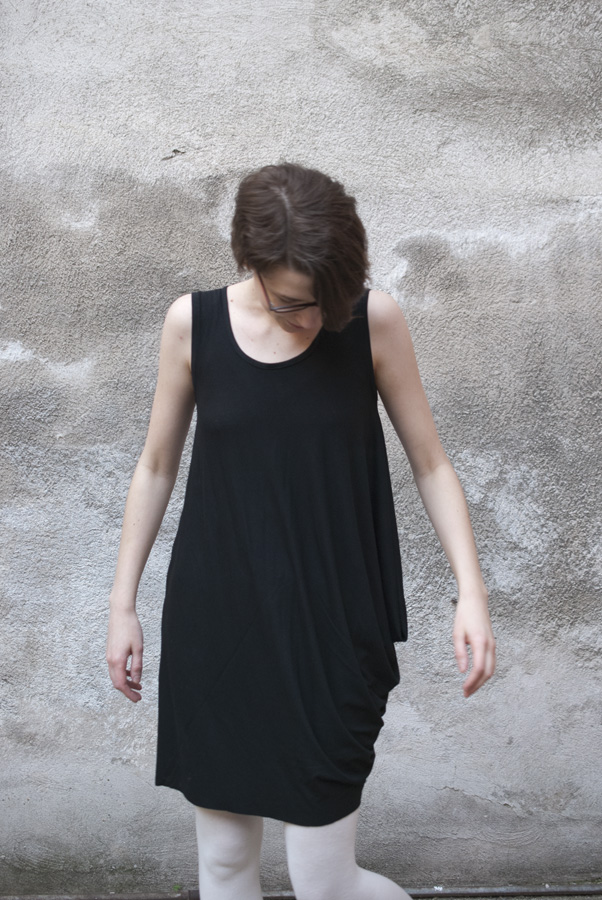Finished: Drape Drape 2, No. 2: Draped Dress
I’ve been intrigued by Japanese sewing patterns for a while, but hadn’t made any yet. I kept looking at book reviews and websites, borrowing books from the library and tracing patterns, but couldn’t decide which one to make up first. I chose this dress when I saw Lizzy’s lovely version—and then her top and another dress from the same book!

Pattern
Dress No. 2 from Hisako Sato’s Drape Drape 2. They call it a “top”, at least in the German version, but it looks very much like a dress to me. I cut the size S/M even though my measurements are between the M and ML sizes (and my height is around an L). I figured the pattern was slouchy enough that I wouldn’t need the larger size, and I was right.

Fabric
A slinky, drapey, stretchy viscose knit in black, from Stoffsalon. I think that it contains some elastane, but I don’t know the exact fibre content. My mum gifted the fabric to me when she changed her mind about the project she was going to use it for. The fabric was over 160cm wide and I used exactly the metre I had, save for some scraps.

Adjustments
- After attaching the bands around the armholes, there was some gaping in the back. I didn’t feel like removing the bands and redoing them, perhaps stretching them slightly—which I thought from the start might be a good idea, but didn’t do because the instructions didn’t say so and I never trust that I know what I’m doing. (Sigh.) So I decided upon a quick fix: I took the dress in at the sides under the armholes—by a wildly different amount on the two sides because they’re asymmetrical (and so am I) and the issue wasn’t as pronounced under the left arm as it was under the right arm. I just put on the dress and pinned out some of the excess fabric in front of my mirror, basted an (estimated) adjusted side seam and re-checked until I was reasonably happy. I’m so glad that this worked out okay!

-
Apparently, I accidentally made a mirror image of the dress in the book. I only noticed when I showed Lizzy’s version to my dad and he pointed out that it has the drape on the other side. I wonder how this happened, I thought that I had put the pattern piece onto the fabric right side up! Oh well, I’m fine with the drape on my left side.
-
I reduced the width of the hem a bit because I thought that I might want to wear the dress without tights in summer and therefore might appreciate a little extra length. (Keep in mind that this is a size S/M and I’m a height L.) [Note that on the photos, the dress isn’t hemmed at all yet. I wanted to take advantage of the lovely weather when we had it, so ran out to take photos before hemming.]
-
I turned the hem up 1.5cm and stitched it down using a twin needle instead of the method suggested in the book. By that time, I didn’t really trust the book more than my instincts any more, so I just did what I wanted to do.

What I want to do differently next time
There just might be a next time, actually! The pattern is very Japanese and slightly eccentric and I didn’t think that I would want more than one version of it—but I like it, and now I really want a stripey version like the one in the book!
- The neckband and armholes gave me quite some grief. I don’t like that the book suggests different methods for attaching the bands—and I struggled with both of them. I gave up on the armhole method and just winged it there. The result doesn’t look as neat as I would like, so I’ll definitely try a different method of attaching the bands next time, and the same method for both the neckband and the armholes.
Photos taken by my boyfriend.